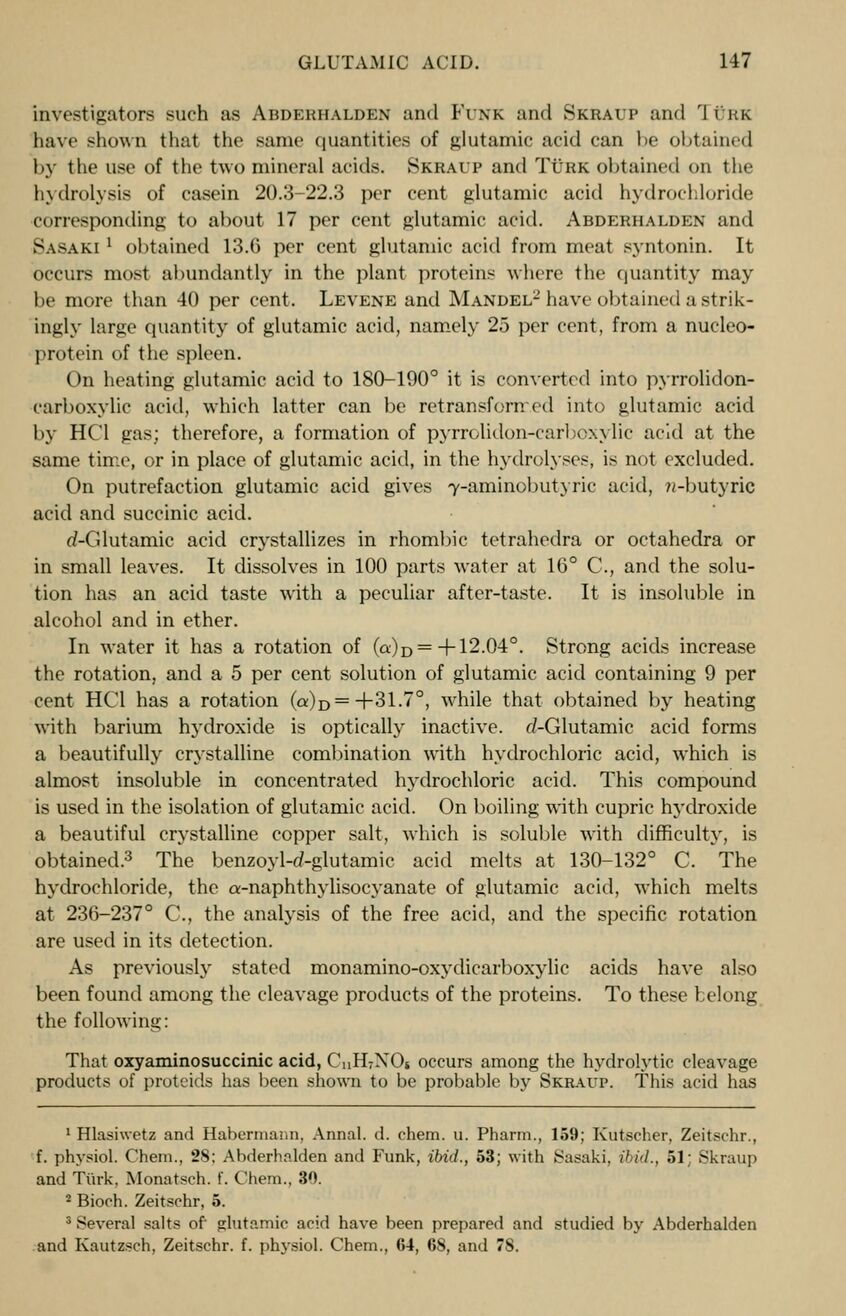
Full resolution (JPEG) - On this page / på denna sida - II. The Protein Substances - I. Simple Proteins - C. Cleavage Products of Simple Proteins - 3. The Amino-acids

<< prev. page << föreg. sida << >> nästa sida >> next page >>
Below is the raw OCR text
from the above scanned image.
Do you see an error? Proofread the page now!
Här nedan syns maskintolkade texten från faksimilbilden ovan.
Ser du något fel? Korrekturläs sidan nu!
This page has never been proofread. / Denna sida har aldrig korrekturlästs.
GLUTAMIC ACID. 147
investigators such as Abderhalden and Ft nk and Skraup and
r
l i’KK
have shown that the same quantities of glutamic- acid can be obtained
by the use of the two mineral acids. Skraup and Turk obtained on the
hydrolysis of casein 20.3-22.3 per cent glutamic acid hydrochloride
corresponding to about 17 per cent glutamic acid. Abderhalden and
Sasaki 1
obtained 13.6 per cent glutamic acid from meat syntonin. It
occurs most abundantly In the plant proteins where the quantity may
lie more than 40 per cent. Levene and Mandel2
have obtains i a strik-
ingly large quantity of glutamic acid, namely 25 per cent, from a nucleo-
protein of the spleen.
On heating glutamic acid to 180-190° it is converted into pyrrolidon-
carboxylie acid, which latter can be retransforn ed into glutamic acid
by HO gas; therefore, a formation of pyrrolidon-cnrbow lie acid at the
same time, or in place of glutamic acid, in the hydrolases, is not excluded.
On putrefaction glutamic acid gives 7-aminobutyric acid, n-butyric
acid and succinic acid.
tf-Glutamic acid crystallizes in rhombic tetrahedra or octahedra or
in small leaves. It dissolves in 100 parts water at 16° C, and the solu-
tion has an acid taste with a peculiar after-taste. It is insoluble in
alcohol and in ether.
In water it has a rotation of (a) D = +12.04°. Strong acids increase
the rotation, and a 5 per cent solution of glutamic acid containing 9 per
cent HO has a rotation (a) D = +31.7°, while that obtained by heating
with barium hydroxide is optically inactive. (/-Glutamic acid forms
a beautifully crystalline combination with hydrochloric acid, which is
almost insoluble in concentrated hydrochloric acid. This compound
is used in the isolation of glutamic acid. On boiling with cupric hydroxide
a beautiful crystalline copper salt, which is soluble with difficulty, is
obtained.3 The benzoyl-d-glutamic acid melts at 130-132° C. The
hydrochloride, the a-naphthylisocyanate of glutamic acid, which melts
at 23(3-237° C, the analysis of the free acid, and the specific rotation
are used in its detection.
As previously stated monamino-oxydicarboxylic acids have also
been found among the cleavage products of the proteins. To these belong
the following:
That oxyaminosuccinic acid, Cu H-XOi occurs among the hydrolytic cleavage
products of proteids has been shown to be probable by Skraup. This acid has
1
Hlasiwctz and Habermann, Annal. d. chem. u. Pharm., 159; Kutscher. Zeitschr.,
f. physiol. Chem., 28; Abderhalden and Funk, ibid., 53; with Sasaki, ibid., 51; Skraup
and Turk, Monatseh. f. Chem., 30.
2
Bioch. Zeitschr, 5.
3
Several salts of £lutamic acid have been prepared and studied by Abderhalden
and Kautzsch, Zeitschr. f. physiol. Chem., 64, 68, and 78.
<< prev. page << föreg. sida << >> nästa sida >> next page >>